|
Sunday, 9/26/10—Venice to Florence
We were up early to pack and have a little breakfast before heading off to Florence. Daira slept in, but Steve walked us to the vaporetto (water taxi). We’ll miss traveling with them. They are headed back to pick up their car in Mestre and drive off to Vienna.
The vaporetto ride out of Venice was particularly lovely because of the dramatic morning light. My eyes drunk in all the beauty and my camera took in all the pixels – a nice way to say good-bye to Venice.
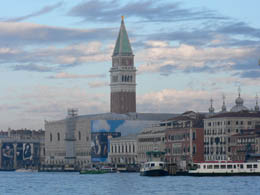
Saying Goodbye to Venice |
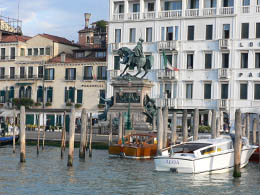
Saying Goodbye to Venice |
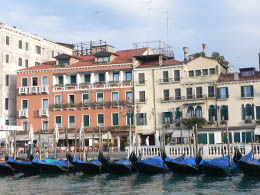
Saying Goodbye to Venice |
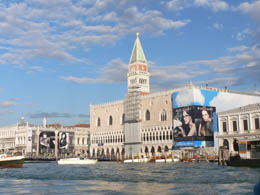
Saying Goodbye to Venice |
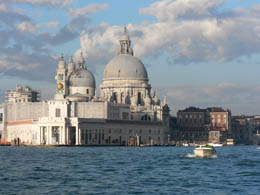
Saying Goodbye to Venice |
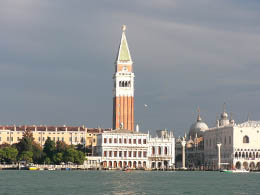
Saying Goodbye to Venice |
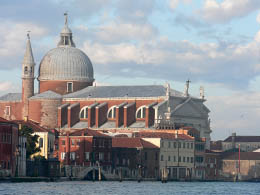
Saying Goodbye to Venice |
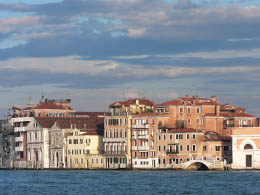
Saying Goodbye to Venice |
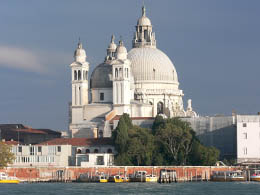
Saying Goodbye to Venice |
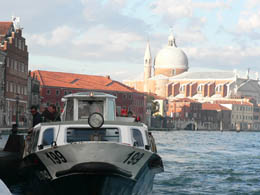
Saying Goodbye to Venice |
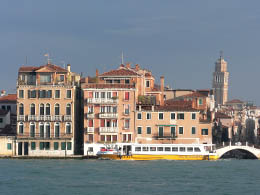
Saying Goodbye to Venice |
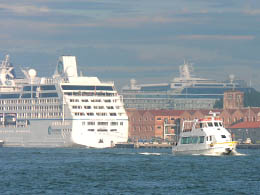
Saying Goodbye to Venice |
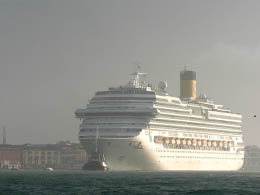
Saying Goodbye to Venice |
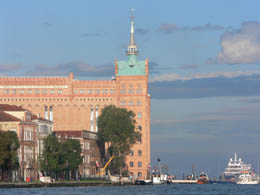
Saying Goodbye to Venice |
We got to the train station in time to catch an earlier train than planned – left at 9:27 am. We had a little confusion finding the right track, the right train, the right car and the right seats, but we managed and settled in for a quiet train ride. I worked on the journal almost the entire 2-hour trip. From time to time I would check out the view from the window -- pretty flat, boring territory from Venice until we hit the hills of Tuscany. It was amazing to see trees and open fields again. I think there is only a half dozen trees in all of Venice – but the architecture is so mind-boggling in Venice, you don’t miss the lack of vegetation.
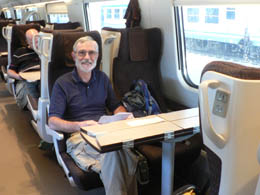
Bill on train to Florence |
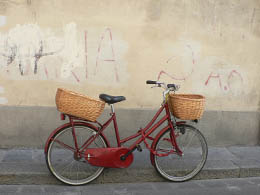
Bike in Florence |
We arrived at the train station in Florence, struggled a little with the bags and the map (the Google map showed our hotel in the wrong block), but Bill found our new home – Hotel Anna’s. It was 3 steep flights up – no lift, but well worth the trouble. The couple who run this place are very helpful and sweet.
We unpacked. Bill found a kitschy place for lunch nearby -- Trattoria Nerone. We had beer, pizza and a big salad. The décor was really wild – I liked it.
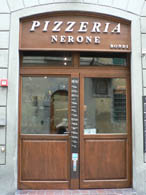
Narone Restaurant |
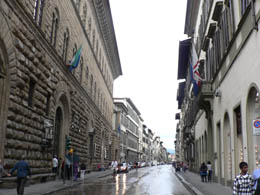
Rainy day in Florence |
I am struck by the scale of Florence with its oversized buildings constructed with oversized gray castle blocks and huge doorways and windows. It’s not delicate like Venice – but massive and overpowering and unified. I’m blown away that the Medici family establish this strong fortress of a town with its lasting style. A lot of testosterone went into this place.
After lunch we tried to go see David in the Academia, but we would have to wait an hour and a half for the viewing. We saw him 20 years ago, so guess that will have to do Too bad because it was a free day at the museum (probably why the lines were so long).
We passed by the Duomo – the most impressive cathedral in all of Europe. Knocked my socks off. Then we stopped to pay homage to Brunelleschi (1377 – 1446). A statue of him sits right across the street from the Duomo. This wild and crazy architect of the Duomo is chiseled in marble and frozen in time looking up at his masterpiece while the pigeons crap on his head.
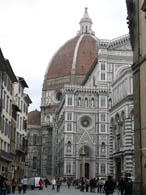
Piazza del Duomo |
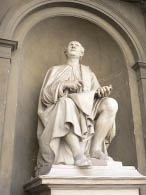
Brunelleschi (1377 – 1446) |
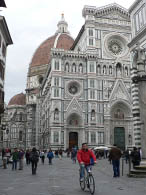
Piazza del Duomo |
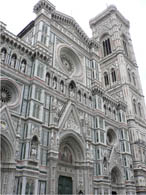
Duomo |
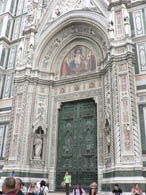
Duomo |
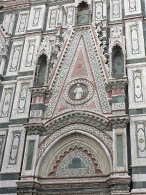
Duomo |
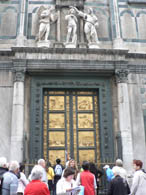
Duomo entry |
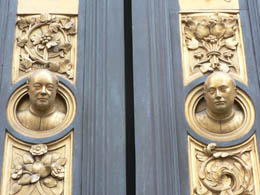
Big brother is watching |
We went to the Bargello, the National Museum housed in one of the oldest buildings in Florence, dating back to 1255. It started out as a medieval palace, then turned prison, then torture chamber a few hundred years later. It was remodeled and now holds some of the great Renaissance treasures (and probably some ghosts from bygone medieval times). One of the most revered treasures is the first silly David statue created by Donatello. David is wearing only a bonnet and boots – but Donatello kicked off the Renaissance. There was a special exhibit on Riscitti, who was the real guy who sparked the Renaissance and inspired his pal Michelangelo. Man I wish I had taken an art history course, or had a little culture to put all this information together. This place rocks, and really rocked back in the 1500’s with all these amazingly talented folks raising the bar with everything they created.
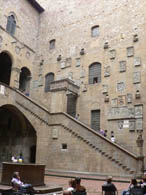
Bargello Museum |
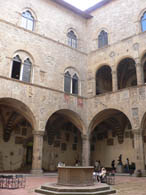
Bargello Museum |
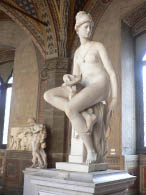
Bargello Museum |
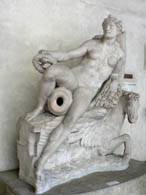
Bargello Museum |
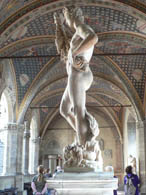
Bargello Museum |
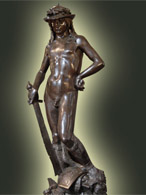
Donatello's David |
| As we were leaving the Bargello, the rains came so we ducked inside a corner café until the downpour passed. We were really wearing out – but went back to check on the line for David at the Academia. The standing time was even longer than before. We had enough culture for the day, so we treated ourselves to some gelato and went back to the room. |
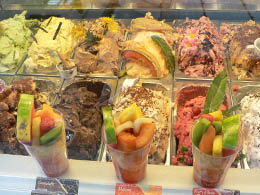
|
Bill tried to get the Internet working – but to no avail. We gave up and went to dinner at Trattoria la Burrasca – described by Rick Steves as “Flintstones” place, and a spot Archie Bunker would frequent. We didn’t think his description made any sense, but we loved the basic, inexpensive, fare. Only about 10 tables – all filled with disciples of Rick Steves. The sight of the sweaty chef was a little disturbing, but boy, did he know how to add rosemary and other spices to the grilled chicken and pork fillet. We wanted to come back the next night – but we learned they were closed.
After dinner, we went back to the train station to get our tickets for Cinque Terra for Tuesday. The ticket booths had already closed at 9 p.m. so we were forced to buy a ticket at a machine. No train number or schedule was printed on the receipt. We came back to our hotel where our friendly, helpful manager gave us a printout of the schedule. We’re in good hands.
It’s getting late and we need rest to cover Florence tomorrow.
Monday, 9/27/10--Florence
Today we immersed ourselves in Florence. My brain is exploding from all the information I stuffed in it.
We found a great breakfast place (Pasticceria) with a great deal – ham and cheese sandwich, pastry, o.j. and cappacino (tea for Bill) for only €3.80. We’ll be back for sure.
We stopped to check our email. We were disappointed not to find much news from home, but no news is good news.
We walked to the Duomo Museum located right across the street from the Duomo. We rented headphones and learned all about the creators of the most magnificent church ANYWHERE. We saw statue after statue and Madonna and child after Madonna and child along with frescos and paintings aplenty. We sucked it all in. We learned about the contest for the design to build the dome and how clever (and crazy) Brunelleschi out-foxed his competitors and got the prized contract to build the Duomo.
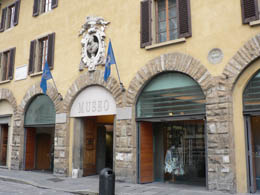
Duomo Museum |
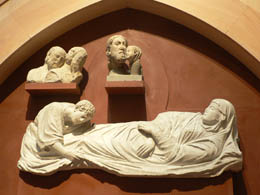
Duomo Museum |
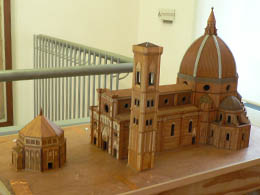
Duomo Museum |
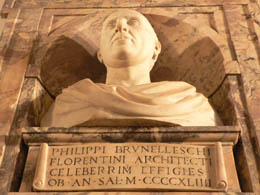
Duomo Museum |
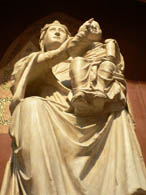
Duomo Museum |
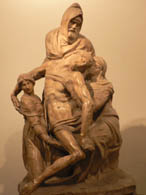
Duomo Museum |
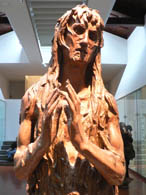
Duomo Museum |
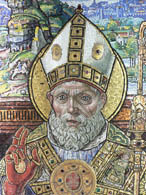
Duomo Museum |
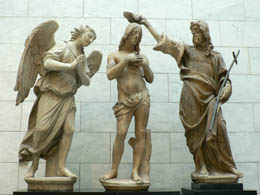
Duomo Museum |
We viewed the scaffolding, all invented for this project with ropes and boards and pulleys all lashed together.
We emerged from the Duomo Museum at 12:30, weakened by the experience. We bought Brian a Dante’s Inferno t-shirt that looks like something a geek would enjoy.
The line into the Duomo cathedral itself looked too long and daunting, so we opted to find some lunch on the way to the Galileo museum. We tucked into a little café to share a ham and cheese sandwich and washed it down with some beer. We were fortified to do our next museum – so off we went.
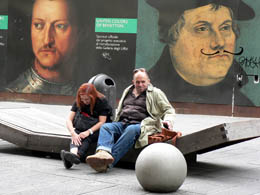
Resting in Florence |
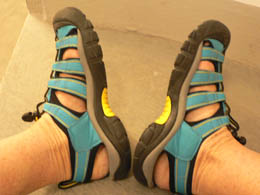
Nancy's tired feet |
We were now ready to do the Galileo museum filled with the chronology of advances in technology. I was happy to put art and Madonnas aside for a while and focus on the technological marvels that were happening as part of the incredible Renaissance period. This was the apex of the awaking, right here, under the Medici Godfathers from the 14th Century until the 18th Century when the Hapsburgs of Austria took over (with Peter Leopold at the helm).
I was so overwhelmed by case after case of inventions that I tried to absorb the information in a theoretical way – so I could come away with a few basic threads of information.
The first room in the museum displayed the sundial and man’s need to understand and define time. Amazing sundials were the thing to have in the late 1400’s. Then the geeks upped the ante and said let’s figure out how to tell time during the night – so the moon dials evolved. From the fixations on the moon, the big thinkers turned to tracking the planets. Then, poor Galileo got into big trouble when he turned the world upside down and said that the earth revolves around the sun. (He paid dearly for that observation.) From planet tracking came the telescope. Galileo’s pitiful, little telescopes were displayed – and to think they changed everything. By the way, the understanding of lenses came from figuring out how the human eye (lens) is tricked by optical illusions. By putting a couple of lenses together in a cylinder, Galileo came up with the telescope. A few decades later, somebody rearranged the lenses and the microscope was born.
Making all these inventions possible was revelation after revelation of mathematics. Pythagoras was doing his C2 = A2 + B2 thing while others were figuring out physics and chemistry. The Medici’s knew the importance of math. They needed triangulation to survey the land that they acquired. They needed soldiers to build fortresses high enough so that the enemy’s cannon balls wouldn’t go over or penetrate the walls. They also needed to design weapons with the trajectory in mind so that their cannon balls would travel far enough and high enough and land hard enough to destroy the enemy. Thus they added new factors to their calculations (i.e., weight of the canon ball, arc of the flight). They also needed good topographic maps for battle strategies. Math was the new requirement in battle.
Math also invaded art with artists discovering drawing with 3-D perspective. From 3-D perspective came more accurate architectural drawings and more complex buildings.
Maps and globes were important tools in running an empire and the museum was loaded with those. Globes were made from printing sections of the globe and pasting them on a wooden ball.
From all the math and science, Florence established a great university, accredited before any other university in these parts, even Paris.
Then came chemistry and understanding different properties of elements and how they contract or expand. Learning about mercury and the weight of air lead to thermometers and predicting the weather (barometric pressure changes). All of these inventions were displayed from their humble beginnings.
Tinkering with electricity and magnets first started out as a curiosity and parlor games for the wealthy. A guest scientist would bring his wheels and probes and magnets to shock the guests -- the word “attraction” was used. These gizmos and gadgets were later employed to teach students about the newly found properties. Then, later, we all know what happened: batteries and producing electrical current would change the world forever.
The Renaissance also touched the medical world. One room displayed new medical instruments, including forceps to be used in delivery. There were also models of different positions of the baby in the birth canal to show how to use the forceps to position the baby for a proper delivery. By the way, the design of the forceps hasn’t changed much from what is displayed in the museum.
We left the museum overwhelmed. We walked to the Point Vecchio (Old Bridge) built over the Arno River. The bridge is loaded with very expensive jewelry shops and lots of crowds. This famous shop area was bombed out during WWII, but was replaced as it once was with shops in Medieval times that also kept the tourists coming back.
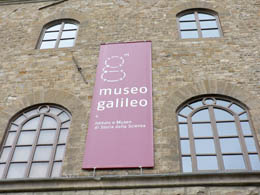
Gallieo Museum |
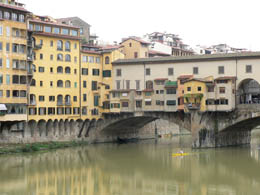
Ponte Vecchio |
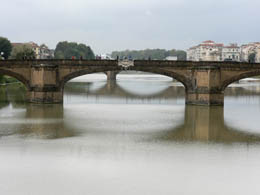
Arno River |
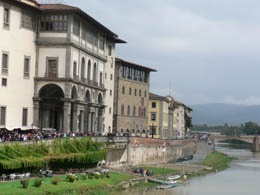
Arno River bank |
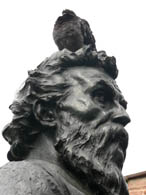
Cellini, famous Goldsmith, on Ponte Vecchio
|
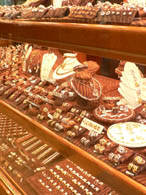
Jewelry shop on Ponte Vecchio |
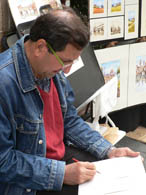
Artist on Ponte Vecchio |
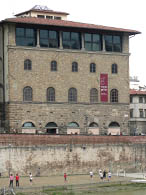
Playing football |
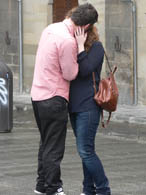
Romance in Florence |
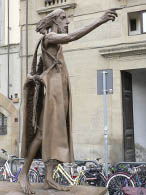
Statue near Arno River |
We dodged cars, motor bikes and a few bicyclers as we made our way to our last museum of the day – St. Croce’s, the oldest church in Florence, built in 1294. We had our gelato on the way, then marched up to St. Croce’s to buy tickets and absorb even more information. I’m glad we did because this church contains the tombs of the very famous Italian talent – Galileo, Michelangelo, Dante, Marconi (inventor of the radio), Rossini (wrote operas), and Machiavelli to name a few. We walked on the tombstones of knights and other rich and famous. We viewed frescos and statues and arches and gold and silver (Madonna’s head done in silver reminded us of Darth Vader). We also viewed the first painting that showed emotion (according to the art historians) -- a guy was throwing his hands up because his pal lay dying.
From the church, we visited the cloisters where the monks slept. Their quarters have been changed into leather shops. You can watch the craftsman producing jackets, belts, and purses, and, of course, buy something.
We left out the side courtyard where we breathed a sigh of relief. We did it. We had covered three major museums and walked our butts off – and this was Monday, an off day for museums (several are closed).
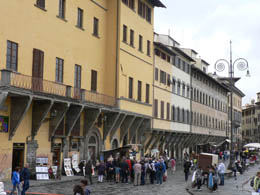
|
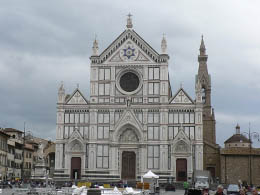
St. Croce’s |
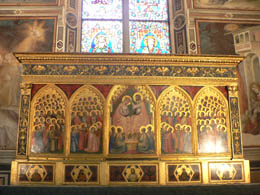
St. Croce’s |
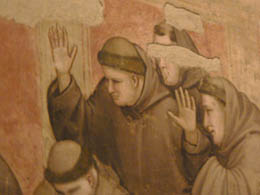
Giotto’s “The Death of a Saint” – 1350, first emotions in paintings |
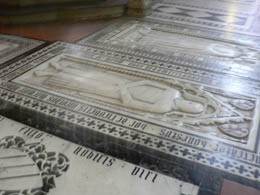
St. Croce’s
|
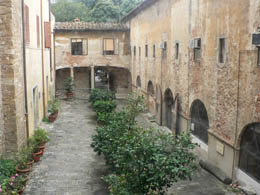
St. Croce’s |
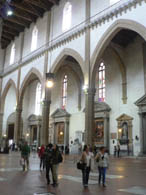
St. Croce’s |
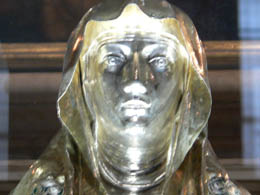
St. Croce’s |
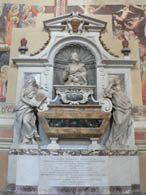
Galileo’s Tomb (He is holding a telescope) |
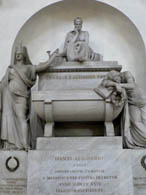
Danti’s Tomb |
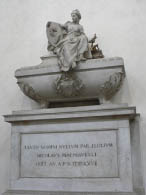
Machiavelli’s Tomb |
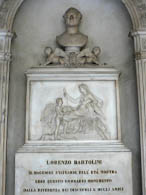
Lorenzo Bartolini’s Tomb |
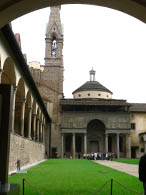
Former Monks Quarters – Now Leather Shops |
We walked back home by way of the Duomo as it was closing. We were sorry to have missed it – but we saw it 20 years ago and that will have to do.
We stopped in to check our email – same place where we started this very long day and then went to our room to regroup for the evening.
At 7:00, we had a lovely dinner at Trattoria Enzo and Piero located right across the street from our hotel and suggested by Lorraine, our hotel manager. Bill fell in love with Valentina, our cute little waitress. He hung on her every word with a big smile plastered on his face. I have to admit she was very charming and had the cutest accent. We had the pre-fixe menu – ravioli and roasted pork with potatoes, hearty Tuscan style. The house wine was lovely and only €5.
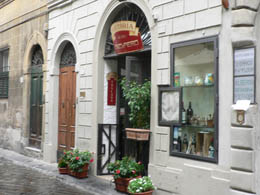
Breakfast spot |
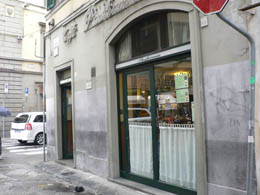
Trattoria Enzo and Piero |
Tuesday, 9/28/10—One More Museum, then Off to Cinque Terra
Noisy city workers started early today, about 5 a.m. with their constant shrilling machines that sounded like they were sucking out the sewer pipes 5 stories below. We gave in and got up about 6:30. We got to our breakfast place right about opening time and ordered the usual – ham and cheese sandwich, pastry, o.j., and cappuccino (tea for Bill).
After breakfast, we walked to the Uffizi – the main reason why we extended our time in Florence. We were here 20 years ago, but were with a bicycling group and just got to see the highlights. We got there 30 minutes before opening and waited in line. Bill held my place in line while I dashed off to snap a few more pictures of Florence. I found David’s imitation statue and snapped away – the real statue is in the Academia museum.
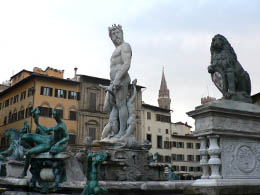
Neptune Fountain, Piazza della Signoria |
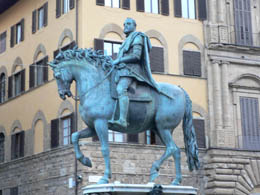
Cosmo Medici i |
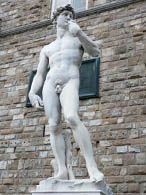
Reproduction of David’s Statue |
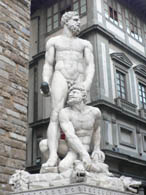
Hercules and Cacus – Bandinelli, 1554 |
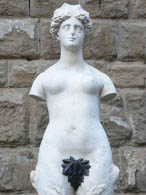
Around the Uffizi |
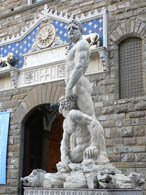
Hercules and Cacus |
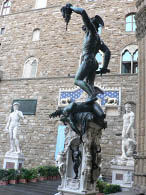
Cellini’s Perseus with beheaded Medusa |
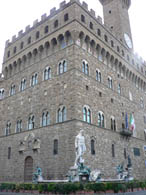
Outside the Uffizi (Admin. Offices, 1560) |
The Uffizi (meaning office building) was built by Cosimo de’ Medici in 1560 to house the Duke of Tuscany’s administrative offices. When Anna Maria Ludovica (the last Medici grand duchess) died in 1737, she gave the people of Tuscany tons of Renaissance and classical art (paintings and statues) that the powerful dukes had collected for over 3 centuries at the height of the Renaissance.
We got an audio guide to point out the real treasures and began our journey through 30 or so rooms with 300 years of the finest art collection anywhere. The rooms were grouped into schools to show the development of Italian and European art. We watched the Madonna and Child paintings go from flat, large forms, void of movement to detailed lined, dimensional representation of bodies and faces. It took a long time to get the Christ baby right. The early babies looked weird, like midget faced adults in little bodies.
The work started with the rebels from the Byzantium period (Cimabue and his pupil Giotto) who changed the little Jesus baby into a glorified red-cheeked chubby cherub that ushered in the Baroque period.
We passed more Madonna’s interspersed with other wonderful and grotesque subjects.
We spent some time in the Botticelli room contemplating his very famous “Venus on the Half Shell.” Why is this particular painting singled out as the great break through? The elements in the painting just don’t seem to relate to each other – but hey, what do I know?
I was, however, very impressed with Leonardo da Vinci’s Adoration of the Magi, even though he didn’t get a chance to finish it.
We both really liked Michelangelo’s Holy Family (1506-08). It was beautiful with tender figures of Mary, Joseph and Jesus on a round canvas in an elaborate gold carved round frame, also created by Michelangelo. Too bad this was one of the few panel paintings by the great artist, but he had a lot of ceilings to cover.
After about 20 rooms, the collection branched out to include the Flemish and German influences (Rubens, Rembrandt). It was easy to spot the differences with the other European artists. I think I could even detect the differences with those that hailed from Venice compared with the really hard core Renaissance dudes from Florence.
With 300 years of art organized for your viewing, it was wonderful to see the change in colors and the addition of perspective, when the mathematical influences were incorporated. It must have been something during that golden age of the Renaissance!
We walked through the last rooms with eyes glazed over – probably missing a number of “greats” along the way. I did spend some time in the Vasari Corridor, commissioned from Vasari by Cosimo I (the top Medici guy). Cosimo had this above ground “tunnel” running along the rooftops of the Ponte Vecchio buildings to connect his family palace (Pitti Palace) with his offices (here in the Uffizi). He did this because he feared it wasn’t safe for him and his family and pals to walk in the streets below. It was very risky business staying top dog, and the Medici family managed quite well for over 300 years. I studied the hundreds of family portraits that lined the Corridor and looked out over the Arno River wondering what this place was like when it was just an office building.
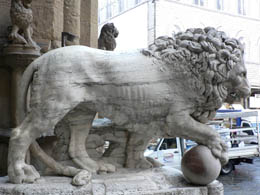
Uffizi |
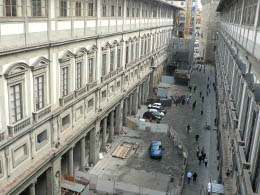
Uffizi
|
We emerged back onto the streets of Florence with a little rain, which we didn’t mind it because it was refreshing and washed down the dark cobblestones and large blocks used to build this place.
We stopped to buy 3 scarves at a vendor’s stand. Everyone is wearing these lovely scarves. Then Bill found our way to the Central Market to have an early lunch. Bill found Nerbone – an original fast food spot from 1871. We ordered the best roast beef sandwich and shared a beer. Was it good!
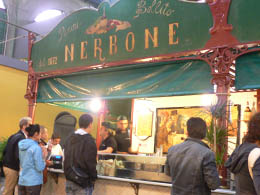
Nerbone |
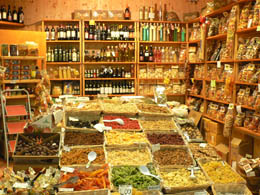
Nerbone |
We went back to the hotel to pick up our luggage and say “good-bye” to Bernardi, a sweet, helpful guy. |











